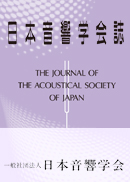巻号一覧

22 巻 (1966)
- 6 号 p. 319-
- 5 号 p. 257-
- 4 号 p. 195-
- 3 号 p. 113-
- 2 号 p. 52-
- 1 号 p. 1-
22 巻, 2 号
選択された号の論文の5件中1~5を表示しています
- |<
- <
- 1
- >
- >|
-
菊池 喜充原稿種別: 本文
1966 年 22 巻 2 号 p. 52-61
発行日: 1966/03/30
公開日: 2017/06/02
ジャーナル フリーAs one of the interesting problems in the fields of physics and electronic engineering, the interaction between electron and elastic waves in solids is generally surveyed. Though phonon-electron interaction and phonon-magnon interaction are really understood as quantum interactions, many phenomena of the interactions are preferably treated with such macroscopic methods as those for the travelling-wave amplification in semi-conductors. The author proposes a new word "acousto-electronics" as the name of this field of learning whitch covers all kinds of interactions between electron and elastic waves in solids, regardless of their theoretical treatments, quantum mechanical one or macroscopical one basing on a phenomenological standpoint. Among the descriptions of the general survey, (i) a new amplifier device of CdS crystal with integrated diffusion-layer transducer and a co-planar construction of the diffusion-layer transducer are briefly explained as the author's proposal for engineering use; (ii) the extinguishing devices for the so-called anomallous oscillation in the travelling-wave amplifier devices are described, which are recentry proposed in Japan; (iii) the noise figure of travelling-wave amplifier is discussed with the author's opinion that the improvement of transducer efficiency directly results in the improvement of the noise figure though difficult because its frequency band should be kept wide enough; and (iv) as a potential engineering interest, the travelling-wave amplification with the use of deformation potential is pointed out, designating this a "large-current small-coupling type" in contrast to the "small-current large coupling type" as of the amplification with the use of piezo-electricity of semiconductors.抄録全体を表示PDF形式でダウンロード (1107K) -
中野 有朋原稿種別: 本文
1966 年 22 巻 2 号 p. 62-71
発行日: 1966/03/30
公開日: 2017/06/02
ジャーナル フリーNoise were measured many times in compartments of various types of ships at trial such as tanker, cargo ship, dredger, patrol boat and destroyer. The results of statistical study on the calculated value of a noise rating number, sound levels and spectra may be summarized as follows. 1) The relation between the noise rating number (Loudness Level, Perceived Noise Level, Noise Rating Number) and sound levels A, B and C, was revealed. The result indicated that good correlation was reached between the noise rating number and the sound level A calculated from the original noise spectra. 2) Ship noises are estimated on calculated regression lines or more simply by adding the resppective figure 14 (LL), 15 (PNL), and -3 (NRN) to the indicated value of the sound level A, so ship noises should be measured by weighting A regardless of sound level. 3) In living compartment, noises, largely solidborne, have a spectrum which decreases at an approximate rate of 5dB/oct in inverse proportion to the number of frequencies with the sounds level A rated at about 70±20dB. In an engine room, however, noises have a spectrum in which most o energy is found at middle and high frequencies with the level rated at about 95±10dB.抄録全体を表示PDF形式でダウンロード (670K) -
中野 有朋原稿種別: 本文
1966 年 22 巻 2 号 p. 72-76
発行日: 1966/03/30
公開日: 2017/06/02
ジャーナル フリーNoises were measured many times on 60, different types of pneumatic machines such as reciprocating and turbo compressors, axial and centrifugal fans, turbo refrigerators and superchagers, at distances ranging from 1 to 30 meters. The results of statistical observation on the calculated value of a noise rating number, sound levels and spectra may be summarized as follows: 1) Like tha case of ship campartment noises, discussed in Report (1), good correlation was reached between the calculated value (LL, PNL, NRN) of the sound rating number of pneumatic machines and the sound level A calculated from the original spectra. 2) The difference between the noise rating number and the sound level A came to 13 (LL), 14 (PNL), and -2 (NRN), each of which was very close to the corresponding value in the case of ship noises. The noise rating number is expressed in terms of the sound level A by averaging the values of the difference published in several literature and the difference mentioned above, as follows: LL=A+13±3, PNL=A+14±2, NRN=A-3±1. 5, In this respect, the sound level A is considered as a good single measure of noises. 3) Noises measured in the neighborhood of each machine has spectrum which has less enagy at low frequencies and more energy at middle and high frequencies, than ship noises with the sound level A rated about 95±10dB.抄録全体を表示PDF形式でダウンロード (363K) -
原稿種別: 付録等
1966 年 22 巻 2 号 p. 79-
発行日: 1966/03/30
公開日: 2017/06/02
ジャーナル フリーPDF形式でダウンロード (71K) -
原稿種別: 付録等
1966 年 22 巻 2 号 p. 102-
発行日: 1966/03/30
公開日: 2017/06/02
ジャーナル フリーPDF形式でダウンロード (57K)
- |<
- <
- 1
- >
- >|